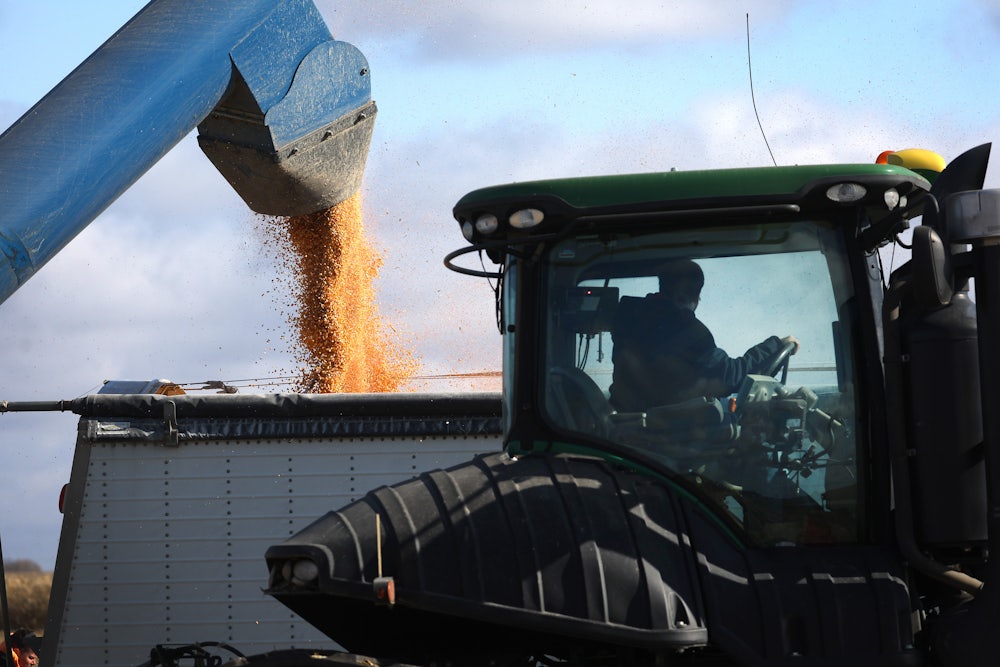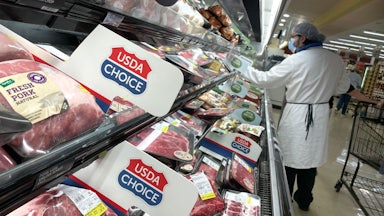For all the backbiting and vitriol, the main candidates in the recent Iowa GOP presidential caucus agreed on a lot of issues, from immigration crackdowns (wonderful) to federal incentives for electric cars (evil). But no topic brought them into more violent consensus than the sanctity of federal support for corn-based ethanol. The heart of the nation’s corn belt, Iowa is the Saudi Arabia of that industry, and Donald Trump and his long-shot rivals all vowed to maintain the federal policies that prop it up.
On this point, they’ll find no argument from the presumptive Democratic nominee. President Joe Biden staunchly supports the practice of turning corn into car fuel, as does his agriculture secretary, Tom Vilsack, who once served as governor of Iowa.
Whether they know it or not, all of these politicians are calling for the government to prop up what is a particularly byzantine and wasteful form of … solar energy. You can’t grow corn without photosynthesis, which converts energy from sunlight into plant tissue. But to liberate this embedded sun power, ethanol-bound corn must be pulverized, inundated with water, fermented, and distilled into alcohol, which can then be mixed with gasoline and burned to power engines. And that’s after the corn is planted, doused with fossil fuel–derived fertilizers, shielded from weeds and insects with toxic chemicals, and harvested.
There’s a more straightforward way to leverage the sun, one that could generate much more energy with a fraction of the fuss: the photovoltaic solar panel, which directly converts sunshine into electricity that can be fed into power grids that, in turn, charge up electric vehicles, which use energy far more efficiently than do internal combustion engines. (Conventional cars convert just 20 percent of the fuel they burn to locomotion, versus nearly 90 percent for E.V.s).
And when it comes to churning out energy on a given piece of land, solar is vastly more efficient than ethanol. According to the 2023 Iowa Climate Statement, signed by more than 200 science faculty at 31 colleges and universities across the state, a “one-acre solar farm produces as much energy as 100 acres of corn-based ethanol” over the course of a year. Dedicating even a fraction of the land now devoted to ethanol to solar panels would produce more energy and ease the ecological burden on our most prolific farming region, the former prairies and wetlands of the Midwest.
Corn, the largest U.S. crop, blankets this rich landscape. Every year, goaded by billions’ worth of federal commodity payments and subsidized crop insurance, farmers plant around 90 million acres of corn—a combined landmass roughly the size of California. Their massive output—nearly 14 billion bushels—accounts for nearly a third of all the corn grown on earth. About 45 percent of it ends up as feed for America’s factory-scale meat farms, another 10 percent goes into sweeteners and starches, and another 14 percent gets exported into the global animal-feed market. That leaves fully 30 percent of U.S. corn production without an obvious place to go, and that’s where ethanol comes in. Rather than downsize their acreage to meet demand for their corn, and then do something else with the freed-up land, farmers maintain all-out corn production, counting on the government to conjure a liquid fuel market to sop up the gaping surplus.
During the late-1970s energy crisis, agribusiness interests succeeded in winning tax breaks that enticed Big Oil to add low levels of ethanol to gasoline. But the big win came in 2007. Shortly after declaring the nation “addicted to oil,” George W. Bush pushed through a bipartisan law with a “renewable fuel standard” that effectively mandated a dramatic increase in corn ethanol production. As a result, the portion of the U.S. corn crop devoted to the fuel rose from 11 percent in 2004 to 30 percent in 2015, where it has held steady. Barack Obama, Donald Trump, and now Joe Biden have all maintained the mandate. As a result, we devote about 30 million acres of prime farmland—an area the size of Virginia—to growing fuel for our cars. Thus U.S. farmers use nearly three times as much acreage growing fuel for outmoded internal combustion engines as they do growing fruits and vegetables.
Stunningly, this enormous commitment of land has done little to fix our reliance on petroleum. While ethanol now makes up about 10 percent of every gallon that goes into our tanks, that number exaggerates its impact. On a per-gallon basis, ethanol produces about two-thirds the energy of gasoline. That means we’re burning nearly a third of our vast corn crop to offset less than 7 percent of gas use.
And despite the political marketing, there isn’t much that’s “renewable” about corn-based ethanol, beyond the ability to grow it year after year. Sown in conjunction with soybeans—another industrial crop whose main uses are livestock feed, processed food ingredients, exports, and car fuel in the form of biodiesel—corn requires massive amounts of fertilizers and pesticides, which leach off fields and drive a growing water pollution crisis throughout the corn belt. Meanwhile, planting and harvesting the same two crops at the same time each year leaves the ground unprotected during the spring and early summer, making it vulnerable to erosion as increasingly fierce storms mobilize bare soil. In a spate of recent papers, a team of University of Massachusetts researchers have calculated that about one-third of the corn belt has already fully lost its carbon-rich layer of topsoil—and what’s left is eroding away at a pace ranging from 10 to 1,000 times the natural rate of replenishment. In short, to grow all of that corn, we’re consuming a crucial resource, soil, that’s not renewable at human time scales.
Nor is ethanol doing much to mitigate climate change—and it may actually be helping drive it. From a greenhouse gas emissions perspective, the Renewable Fuel Standard has failed, says Jason Hill, a professor at the University of Minnesota’s Department of Bioproducts and Biosystems Engineering. By displacing a small amount of oil, the law made conventional gasoline a little cheaper, which inspired people to drive more while buying less fuel-efficient vehicles than they would otherwise have. As a result, Hill and two colleagues found in a 2016 paper, the net effect of the law was to boost greenhouse gas emissions from cars by about 22 million metric tons of carbon dioxide annually, equivalent to the output of nearly six coal-fired power plants. Then there’s all the nitrogen fertilizer, which when applied to farm fields emits an annual tsunami of nitrous oxide, a greenhouse gas nearly 300 times more potent than carbon. Hill and his colleagues have found that nitrogen fertilizer applied to corn also results in emissions of ammonia, a powerful pollutant, that have been associated with 4,300 premature U.S. deaths each year.
Rather than hew to this grim status quo, we could generate more—and much cleaner—energy by phasing out ethanol and dedicating a fraction of the land that grows this feedstock to solar panels. For landowners who would be loath to stop farming and become energy producers, there’s no reason to have to choose between the two. A group of researchers at Purdue University have developed P.V. panels designed to work in conjunction with field crops. They go vertical when farm machinery needs to pass, and otherwise adjust to “optimize the amount of electricity generated and the amount of light that crops receive” as the growing season proceeds. The mixing of solar panels and crops—known as “agrivoltaics”—is much more worthy of federal support than ethanol. Why not shift the subsidy from planting corn to installing panels?
But no one is talking about planting solar panels from fencerow to fencerow across the state of Iowa. To replace the energy generated by the ethanol mandate would require only about one million acres—just 3 percent of the land now cultivated for corn-based car fuel. With the remaining land, now freed from energy production, farmers could be incentivized to try out forms of agriculture proven to grow plenty of food while also sucking up carbon, holding soil in place, and keeping water clean—like interspersing row crops, including oats, wheat, or even vegetables, with fruit and nut trees, a practice known as agroforestry. Or they could be paid to return some land to native prairie, savanna, and wetland, which would also sequester carbon and improve downstream water quality.
The real challenge isn’t figuring out better uses for land than churning out a low-quality fuel for a soon-to-be-obsolete form of transportation. It’s debunking the misbegotten pro-ethanol consensus that’s so potent among the political class that it unites such otherwise warring figures as Donald Trump and Joe Biden.
This story was produced in partnership with the Food & Environment Reporting Network, a nonprofit news organization.








